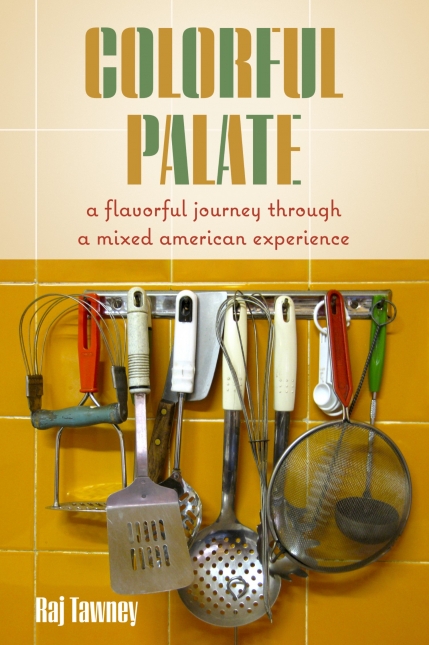Colorful Palate: A Flavorful Journey through a Mixed American Experience
- By Raj Tawney
- Fordham University Press
- 160 pp.
- Reviewed by Alice Stephens
- October 18, 2023
A food-filled recollection of growing up brown in suburban New York.

Though America has long been described as a melting pot, it wasn’t until the 2000 census that respondents had the option of claiming more than one racial or ethnic category. From 1980 to 2013, the number of reported interracial marriages almost quadrupled. As a mixed-race person, I’ve noticed over the decades that the average urban American is beginning to look more like me and less like my overwhelmingly white elementary-school classmates. This is due to both the Immigration and Nationality Act of 1965 (which finally relaxed restrictions on non-European immigration) and the abolition of state anti-miscegenation laws.
Born in Elmhurst, Queens, approximately two decades after the landmark 1965 act, Raj Tawney, the author of Colorful Palate: A Flavorful Journey through a Mixed American Experience, wonders at his parents’ audacity:
“When an Indian immigrant from Mumbai married a Puerto Rican and Italian American woman from the Bronx in 1981, how the hell did they think they’d be received? With open arms and minds? Love between two people is powerful, but not everyone can accept an unfamiliar mixture.”
Shortly after Tawney’s birth, his parents escape to the safe suburb of Commack, Long Island, “so their children wouldn’t have to be raised amid violence and crime.” But once there, they face a new problem: the prejudice of their white neighbors. On his first day of kindergarten, Tawney not only discovers that it’s uncool to wear Barney-themed clothing, but also that there is something fundamentally uncool about him. His classmates make fun of his hair and the way he smells, his teacher can’t pronounce his name, and the administration doubts he can speak English.
However, amid the hurt and confusion he endures from other people’s misconceptions about him, he always finds refuge in home-cooked food, which he loves to help his mother and grandmother, Nani, prepare. His favorite dishes, from tandoori chicken to Italian meatballs to arroz negro, reflect his mixed heritage. For each life challenge, Tawney finds comfort in a particular dish, ending every chapter with a recipe.
The memoir’s chronological narration explores the various facets of the author’s heritage: visiting his Puerto Rican Nani in the Bronx, where he must run a gauntlet of gambling day-drinkers on his way to her apartment; the elaborate parties given by his father’s financially successful Indian acquaintances where his mother is snubbed and ridiculed as an outsider; navigating adolescence as an aspiring rapper; finding his way into adulthood with the help of an elderly rainbow-cookie-loving cinephile; and meeting and wooing his Italian-French-German-American wife.
In addition to food and the author’s coming-of-age, the book’s other main narrative thread is Tawney’s parents’ growing estrangement due to personality and cultural differences, culminating in separate bedrooms and communicating through their children. Tawney’s father is extremely social, eager to ingratiate himself to his wealthier Desi colleagues and unwilling to sympathize with his wife, who is ostracized for not being Indian and subjected to catty insults. The author only comes to understand the extent of his mother’s torment when his wife-to-be is subjected to the same treatment:
“I finally realized why Mom had struggled for so many years. She’d had enough of subtle cruelty and the lack of emotional support from her husband.”
The book loses focus when recounting Tawney’s intermittent college career and attempts to make it in the music business. Other than a salty observation on Eminem’s popularity, the author doesn’t closely examine the nuances and implications of a mixed-race suburban Long Island kid trying to make it in a traditionally Black genre, preferring instead to describe the vicissitudes of life on the road. His ethnic heritage fades into the background as he discovers classic cinema, meets the love of his life, and establishes himself in a career. The bland final chapters could describe any ingénue discovering culture and building community.
Tawney’s writing style is conversational, at times sophomoric, always enthusiastic. The recipes, which occasionally come off as advertisements for Goya products, are not for nervous cooks, with imprecise instructions like “pour in a couple swigs of milk” and “chop 1 large onion and add to the pan to lightly sweat.” While the title and recipes might have been meant to capitalize on the success of food-related memoirs like Michelle Zauner’s Crying in H Mart and Stanley Tucci’s Taste: My Life through Food, Colorful Palate is best read as a snapshot of suburban New York life at the turn of the 21st century.
Alice Stephens checks four boxes on her census form.

